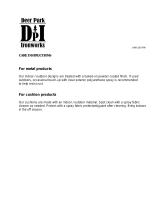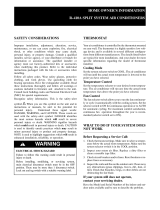
421 02 5000 03 10/17/16
HOME OWNER’S INFORM
TION
Split System Air Conditioner
Our products are designed, tested and built in accordance with DOE standardized procedures; however, actual operating re-
sults and efficiencies may vary based on manufacturing and supplier tolerances, equipment configuration, operating condi-
tions and installation practices.
THERMOSTAT
Your air conditioner is controlled by the thermostat mounted
on your wall. The thermostat is a highly sensitive low voltage
device and is available in several dif ferent configurations
from different manufacturers. The details listed below are
typical for most installations. Ask your dealer for more spe-
cific information regarding the model of thermostat installed.
Cooling Mode
Set the system selector switch to COOL. The air conditioner
will run until the actual room temperature is lowered to the
point you have selected.
Temperature Control
Set the temperature selector to your desired room temperat-
ure. The air conditioner will run any time the actual room
temperature rises above the point you have selected.
Fan Control
The fan selector switch allows you to run the fan continu-
ously or cycle it automatically with the cooling system. Set
the selector switch to ON for continuous operation or to
AUTO for automatic cycling. For maximum comfort satisfac-
tion, continuous fan operation throughout the year is recom-
mended (selector switch set to ON).
WHAT TO DO IF YOUR SYSTEM DOES
NOT WORK
Before Requesting a Service Call:
1. Check thermostat settings. Make sure to select a tem-
perature below the actual room temperature. Make sure
the system selector switch is in the COOL position.
2. Inspect your return air filter. Replace a dirty filter or clean
a reusable type filter.
3. Check circuit breakers and/or fuses. Reset breakers or
replace fuses as necessary.
4. Inspect the coils and fins on the outdoor unit. Clean away
any obstructions (grass clippings, leaves, dirt, dust, or
lint). Check that branches, twigs, or other debris are not
obstructing the fan blade.
If your system still does not operate, co n tact
your servicing dealer.
Have the Model and Serial Numbers of the indoor and out-
door units available and be sure to describe the problem.
REGULAR MAINTENANCE
REQUIREMENTS
Your system should be regularly inspected by a qualified
service technician. Between visits, there are some routine
maintenance procedures you can do to help keep your sys-
tem operating at peak performance.
!
WARNING
ELECTRICAL SHOCK HAZARD
Failure to turn off electrical power could result in per-
sonal injury or death.
Turn OFF all electrical power to both the indoor and
outdoor units before performing any maintenance or
removing any panels or doors. There may be more
than one electrical disconnect switch.
Air Filter
Inspect air filters at least monthly and replace or clean as re-
quired. Disposable type filters should be replaced. Reusable
type filters may be cleaned by soaking in mild detergent and
rinsing with cold water. Install filters with the arrows on the
side pointing in the direction of air flow.
Dirty air filters are the most common cause of inad-
equate cooling performance, and of compressor
failures.
Condensate Drain
The indoor coil condenses water from the air, and this water
must be disposed through an appropriate drain system. Dur-
ing the cooling season check at least monthly for free flow
of drainage and clean if necessary.
Outdoor Unit Coils
Grass clippings, leaves, dirt, dust, lint from clothes dryers,
and fall- off from trees can be drawn into coils by movement
of the air. Clogged outdoor coils will lower the efficiency of
your unit and could cause damage to the compressor. Clean
debris away from the outdoor coils.
Use a soft bristle brush with light pressure only. Do not dam-
age or bend coil fins. Damaged or bent fins may affect unit
operation.
Painted Surfaces
In geographical areas where the water has a high concen-
tration of minerals (calcium, iron, sulfur , etc.) it is recom-
mended that lawn sprinklers not be allowed to spray on the
unit. Spraying this type of water on the unit may result in pre-
mature deterioration of the paint finish and metal compon-
ents.
Never use a weather cover over the outdoor unit unless it is
a ventilated type or made of breathable fabric that will allow
moisture to evaporate rapidly. A cover that holds moisture
in the unit will cause more rust build- up and damage than
normal exposure to weather .



